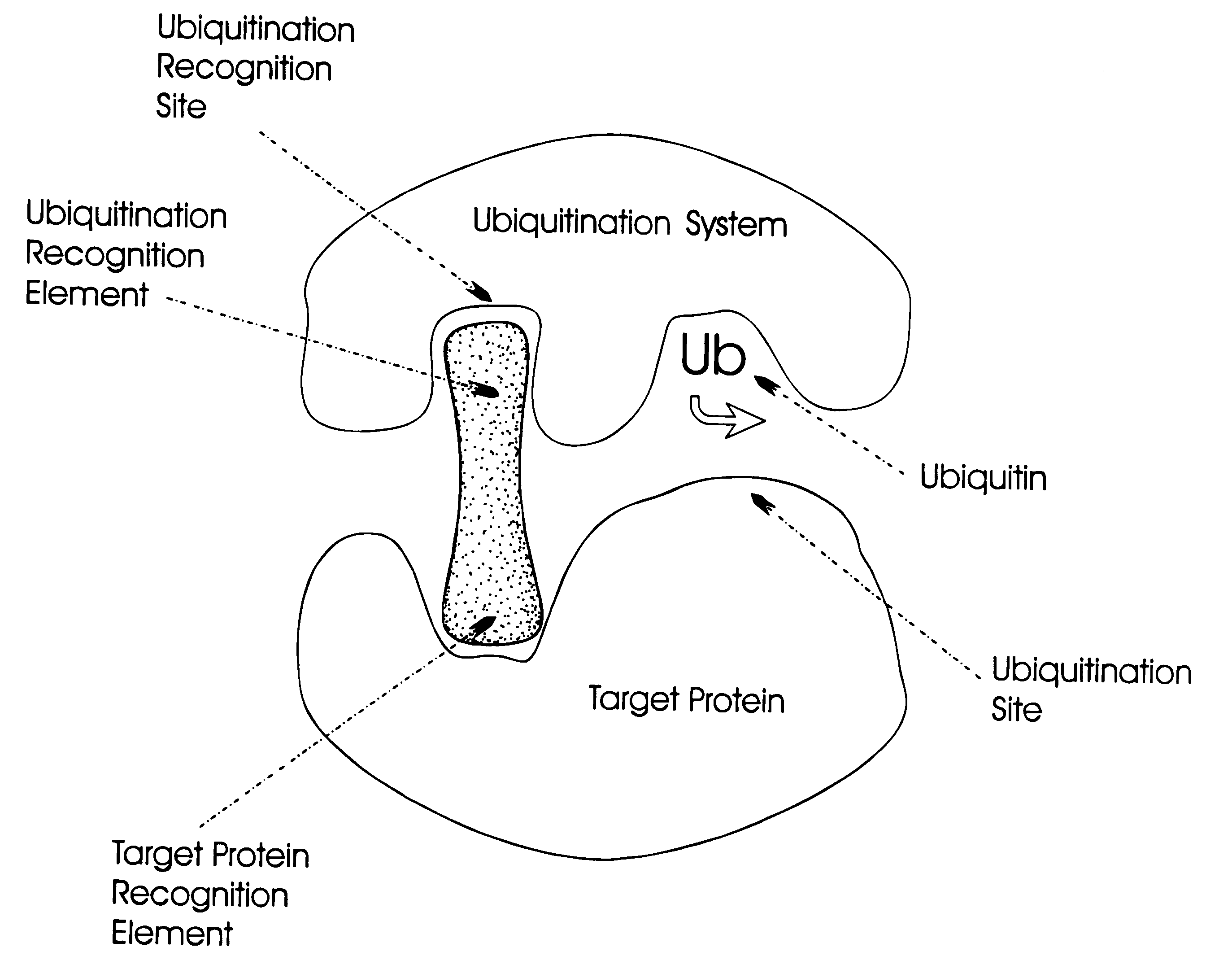Controlling protein levels in eucaryotic organisms
a technology of eucaryotic organisms and protein levels, applied in the direction of viruses, peptide/protein ingredients, depsipeptides, etc., can solve the problems of specificity problems, difficult to achieve the level of therapeutic effect desired, and unstable metabolism in a free state, etc., to achieve cost-effective effects and improve activity
- Summary
- Abstract
- Description
- Claims
- Application Information
AI Technical Summary
Benefits of technology
Problems solved by technology
Method used
Image
Examples
example 1
Targeted Degradation of HIV Integrase
Expression and Purification of His.sub.6 -HIV Integrase
Full length HIV-1 IN is expressed in E. coli and purified by the established protocols of Craigie, R., Hickman, A. B. and Engelman, A. (1995) in HIV Volume 2: A Practical Approach, pp53-71, J. Karn ed., Oxford Univ. Press, New York. The pINSD.His plasmid, containing the HIV-1.sub.NL4-3 coding sequence inserted in the pET-15b His.sub.6 expression vector (Novagen), is available from the NIAID AIDS Research and Reference Reagent Program as transformed HB101. pINSD.His is prepared using a Qiagen plasmid purification kit, and transformed into BL21(DE3) by electroporation for expression in shaker flask cultures by Protocol 2, from Craigie, R., Hickman, A. B. and Engelman, A. (1995) in HIV Volume 2: A Practical Approach, pp53-71, J. Karn ed., Oxford Univ. Press, New York. Following Protocol 4, as described in Craigie, R., Hickman, A. B. and Engelman, A. (1995) in HIV Volume 2: A Practical Approach, ...
example 2
Selection, Discovery and / or Evaluation of Ubiquitination Recognition Elements
In order to determine if a given molecule or molecular element is potentially valuable as a ubiquitination recognition element the assay described above is run with [.sup.125 I]-lysozyme or other labeled protein substrates in the presence of potential ubiquitination recognition elements.
In the case of Arg-.epsilon.Ahx-Cys, Phe-.epsilon.Ahx-Cys these were run in the reticulocyte lysate using lysozyme and both demonstrated inhibition of the lysozyme degradation as expected for ubiquitination recognition elements. The results at the 2 hour time point were 12,475 cpm for no treatment, 6,486 cpm for the 2 mM Arg-.epsilon.Ahx-Cys treatment and 3,592 cpm for the 5 mM Phe-.epsilon.Ahx-Cys treatment. These results indicate that a ubiquitination recognition element can be made from X-.epsilon.Ahx-linker where X is an amino acid involved in the N-end recognition and the linker is chemistry which links this to a bindin...
example 3
Targeted Degradation of Glutathione S-transferase
Conjugation of Ubiquitination Recognition Elements to Glutathione (FIG. 6)
4.18 mg (15.1 .mu.mol) bismaleimidohexane (BMH, Pierce, Rockford, Ill.) in 200 .mu.L of dimethylformamide was added slowly to 1.84 mg (6 .mu.mol) glutathione in 2 mL 20 mM potassium phosphate pH 7.0 The reaction was followed by C.sub.18 reverse phase HPLC. After 30 min at room temperature, the reaction mixture was centrifuged at 12,000 rpm for 2 min to remove precipitate, and the sample was loaded onto a C.sub.18 Sep-Pak cartridge pre-equilibrated with H.sub.2 O. The bound sample was washed with 2 mL of 10% methanol / H.sub.2 O and eluted in 3 1-mL fractions of 50% methanol. The second 1 mL product fraction was partially concentrated by evaporation of the methanol. This activated glutathione was then reacted with the various ubiquitination recognition elements.
For example for Arg-.epsilon.Ahx-Cys the activated glutathione was added to 50 .mu.L of 20 mg / mL Arg-.eps...
PUM
| Property | Measurement | Unit |
|---|---|---|
| partition coefficient | aaaaa | aaaaa |
| partition coefficient | aaaaa | aaaaa |
| half life | aaaaa | aaaaa |
Abstract
Description
Claims
Application Information
 Login to View More
Login to View More - R&D
- Intellectual Property
- Life Sciences
- Materials
- Tech Scout
- Unparalleled Data Quality
- Higher Quality Content
- 60% Fewer Hallucinations
Browse by: Latest US Patents, China's latest patents, Technical Efficacy Thesaurus, Application Domain, Technology Topic, Popular Technical Reports.
© 2025 PatSnap. All rights reserved.Legal|Privacy policy|Modern Slavery Act Transparency Statement|Sitemap|About US| Contact US: help@patsnap.com



